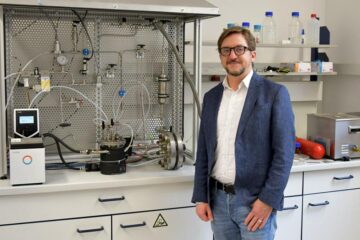Concerns raised over safety criteria for blast resistance

Buildings built according to federal design criteria to be able to withstand earthquakes may not be able to survive the effects of explosions from bombs small enough to be carried by a terrorist, Penn State Protective Technology Center (PTC) researchers have found.
Dr. Theodor Krauthammer, PTC director and study leader, says, „Our analyses show that three dimensional structural steel welded connections designed to resist the effects of earthquakes may fail when subjected to small bomb blasts even when the structure is based on recommended design procedures.“
The steel design specifications, known as the Federal Emergency Management Agency (FEMA) 350 or the Seismic Recommended Design Criteria for New Steel Moment-Framed Buildings, were issued after recent earthquakes in the U.S. highlighted weaknesses in the design and construction of steel connections.
„Important design modifications were introduced into these seismic design guidelines following the assessments of earthquake performance,“ Krauthammer explains. „Now, our preliminary study has produced findings that raise concerns about the safety of using the modified structural steel connections for blast resistance.“
He presented his findings Wednesday, Nov. 6, at the First Annual Congress on Infrastructure Security for the Built Environment meeting in Washington, D. C. His paper, co-authored with current and former graduate students, is „Three Dimensional Steel Frame Connections Under Blast Loads.“
The research team used computer simulations and numerical studies that had been validated to insure that they can reproduce real-world behavior. The test model was a hypothetical one-story frame steel structure in a multi-story building with corner connections, cross section members and columns sized to resist earthquake conditions. The internal blast simulated, approximately, a small 25-pound bomb, the range of explosive capable of being carried by a terrorist.
The rotation produced by the blast at the structure’s connections is typically used to assess structural damage. The Penn State team’s analysis showed that all the connections exhibited very large rotations or outright failure, indicating that all such connections could be expected to fail.
The Penn State engineer says, „The failure is localized in the vicinity of the explosion. However, the local failure could compromise the stability of the entire multi-story building if it triggers progressive collapse.
„Our on-going studies are aimed at addressing the issues raised during this investigation, including consideration of progressive collapse of multi-story buildings,“ Krauthammer adds.
###
Media Contact
Weitere Informationen:
http://www.psu.edu/Alle Nachrichten aus der Kategorie: Architektur Bauwesen
Die zukunftsorientierte Gestaltung unseres Wohn- und Lebensraumes erhält eine immer größer werdende Bedeutung. Die weltweite Forschung in den Bereichen Architektur und Bauingenieurwesen leistet hierzu einen wichtigen Beitrag.
Der innovations-report bietet Ihnen hierzu interessante Berichte und Artikel, unter anderem zu den Teilbereichen: Nachhaltiges Bauen, innovative Baumaterialien, Bautenschutz, Geotechnik, Gebäudetechnik, Städtebau, Denkmalschutz, Bausoftware und Künstliche Intelligenz im Bauwesen.
Neueste Beiträge

Ideen für die Zukunft
TU Berlin präsentiert sich vom 22. bis 26. April 2024 mit neun Projekten auf der Hannover Messe 2024. Die HANNOVER MESSE gilt als die Weltleitmesse der Industrie. Ihr diesjähriger Schwerpunkt…

Peptide auf interstellarem Eis
Dass einfache Peptide auf kosmischen Staubkörnern entstehen können, wurde vom Forschungsteam um Dr. Serge Krasnokutski vom Astrophysikalischen Labor des Max-Planck-Instituts für Astronomie an der Universität Jena bereits gezeigt. Bisher ging…

Wasserstoff-Produktion in der heimischen Garage
Forschungsteam der Frankfurt UAS entwickelt Prototyp für Privathaushalte: Förderzusage vom Land Hessen für 2. Projektphase. Wasserstoff als Energieträger der Zukunft ist nicht frei verfügbar, sondern muss aufwendig hergestellt werden. Das…





















